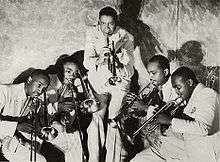Mills Blue Rhythm Band
The Mills Blue Rhythm Band was an American big band of the 1930s.
The band was formed in Harlem in 1930, with reedman Bingie Madison the first of its many leaders. It started life as the Coconut Grove Orchestra, changing to Mills Blue Rhythm Band when Irving Mills became its manager in 1931. At various times the same group was known as the "Blue Rhythm Band", "Blue Ribbon Band", "Blue Rhythm Boys", "The Blue Racketeers", "Earl Jackson's Musical Champions", "Earl Jackson and his Orchestra", "Duke Wilson and his Ten Blackberries", "King Carter's Royal Orchestra", "Mills Music Masters", "Harlem Hot Shots"[1] and uncredited playing behind Louis Armstrong.
The Mills Blue Rhythm Band were based at The Cotton Club in Manhattan. They worked steadily through the 1930s deputizing for the Duke Ellington and Cab Calloway Orchestras; often taking their undesirable engagements.[2] Violinist Carroll Dickerson briefly fronted the band, followed by Drummer Willie Lynch in 1931 and then compere Jimmy Ferguson (Baron Lee). Edgar Hayes, Eddie Mallory and Dave Nelson all had temporary stints as band leader until Lucky Millinder permanently took over the role in 1934.
The band recorded 150 sides for a variety of labels including Brunswick, Columbia, Victor, the ARC stable of labels (including Oriole, Perfect, Regal, Romeo, Banner, Melotone, Domino), Variety, and Vocalion. Despite success with a few hit records (including "Truckin'" and "Ride, Red, Ride") and a strong lineup of talented soloists, the group never attained the prominence of their peers. This is often attributed to the lack of a single identifiable leader,[3] and Irving Mills' preference to have the band perform an understudy role.
The group disbanded in 1938. Millinder joined Bill Doggett's band before reforming it into his own orchestra in 1940[4]
Irving Mills revived the Mills Blue Rhythm Band name for two recording sessions in 1947 under the guidance of Van Alexander. The only original band member at either of the 1947 sessions was trumpeter Charlie Shavers.
Many of the Mills Blue Rhythm Band's recordings are now considered jazz classics by collectors. Original records regularly appear on auction lists, and recent reissue and remastering projects have made their recordings more widely available.
Members
- Henry "Red" Allen, trumpet
- Buster Bailey, clarinet
- Wilbur de Paris, trombone
- Carroll Dickerson, violin
- Harry "Sweets" Edison, trumpet
- Joe Garland, tenor saxophone, arrangements
- Edgar Hayes, piano
- Shelton Hemphill, trumpet
- J. C. Higginbotham, trombone
- Charlie Holmes, alto saxophone
- Benny James, banjo, guitar
- Wardell Jones, trumpet
- Billy Kyle, piano
- Lawrence Lucie, guitar
- Castor McCord, saxophone
- Ted McCord, saxophone
- Gene Mikell, clarinet, alto saxophone,
- Lucky Millinder, bandleader
- Charlie Shavers, trumpet
- Tab Smith, alto saxophone
- O'Neill Spencer, drums
- George Washington, trombone
- Crawford Wethington, clarinet, alto saxophone, baritone saxophone
References
- ↑ The Duke Ellington Music Society
- ↑ Chilton, John, Ride, Red, Ride, Continuum International Publishing Group, p. 80, ISBN 0-8264-4744-9
- ↑ The Mills Blue Rhythm Band AJA5634 : Jazz CD Reviews- 2006 MusicWeb International
- ↑ Lucky Millinder career overview at Southern Music Network
